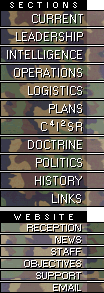




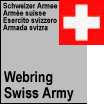
Predator Hellfire Missile Tests "Totally Successful"
May 12, 2001
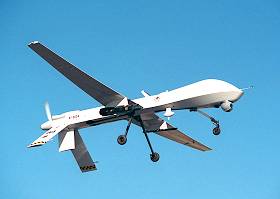
he Air Force's Predator Unmanned Aerial Vehicle made aerospace history Feb. 21 as it successfully launched a live Hellfire missile helping it evolve from a non-lethal, reconnaissance asset to an armed, highly accurate tank killer.
"Capping a three-part series of demonstration flight tests, Predator successfully aimed and launched a 'live' Hellfire-C, laser-guided missile that struck an unmanned, stationary Army tank on the ground at Indian Springs Air Force Auxiliary Airfield near Nellis Air Force Base, Nev.," said Major Ray Pry, Predator program manager, Big Safari Program Office at ASC's Reconnaissance Aircraft System Program Office.
hit the turret dead-square in the middle, and spun it partially around. "
hit the turret dead-square in the middle, and spun it partially around. "
"Flown" by two Air Combat Command crew-members, a pilot and sensor-operator from the 53rd Test and Evaluation Group at Nellis, located in a nearby Ground Control Station, Predator launched the missile using Line-of-Sight communication, inflicting heavy damage to the tank, Pry said.
The final flight, part of a Phase I feasibility demonstration that began in August 2000, was preceded by two similar, completely successful Hellfire launches Feb. 16 and earlier Feb. 21, according to the major. This first recorded missile launch from a UAV took place Feb. 16 at approximately 11:05 a.m. Pacific Daylight Time (PDT).
"Equipped with a single, inert Hellfire-C missile, the Predator, using its LOS communication band and infrared 'Kosovo' laser-ball, aimed and struck the tank-turret about six inches to the right of dead-center, spinning the turret around about 30 degrees," Pry said. "It made a big, gray dent in the turret - just beautiful."
To find a target and eliminate it
Following the first launch, the Predator-Hellfire launch team reviewed telemetry data and camera footage captured by the GCS crew and a helicopter from the Nellis Range, Pry said. "We wanted to be sure we captured what we thought we had seen - that the stress and loads were within Predator's limits, and that the guides worked perfectly," he explained. "With two shots planned for Feb. 21 using both satellite and LOS communications links, we wanted to ensure we could use the satellite link to fire the missile."
Assembling at 4:30 a.m. local Nellis time, the team flew the Predator for 10 to 15 practice runs, doing simulated missile set-ups and launches, Pry said. "At approximately 9:30 a.m., the conditions were favorable for a live run, and the 53rd Test and Evaluation Group operators were ready," he said. "We executed the launch using the satellite link for the first mission. This successful launch met a key goal of the first phase of the demonstration.
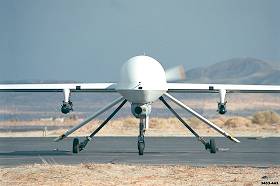
"We came in on final approach, about seven kilometers from the tank, turned the laser off just shy of five kilometers and launched the inert Hellfire," Pry said. "About seventeen seconds later, the missile impacted the side of the tank, hit the turret dead-square in the middle, and spun it partially around."
Pry said test teams inspected the damage to the turret and reset all parameters to use the LOS communications link for the live missile shot next. After a whole series of run-ins, to make sure the entire team was "in sync," they went through another pass with the same exact mission profile as the previous launch, and loosed the live Hellfire. "The missile exploded as planned against the side of the tank," he said.
with the ability to find a target, then eliminate it. "
with the ability to find a target, then eliminate it. "
The weaponized Predator is the brainchild of Gen. John P. Jumper, top commander of the Air Force Air Combat Command. He tasked Air Force Acquisition to "demonstrate a weaponized UAV" with the ability to "find a target, then eliminate it."
The Hellfire missile was chosen to arm the UAV because of its proven track record from Desert Storm back to the 1980s, its availability as a mature missile with all platforms still in production today, its weight of approximately 100 pounds and its relative ease of integration, said Lt. Col. Dennis Bleckley, assistant project manager of production and international operations in the Aviation Rockets and Missiles project office.
Although the Army team was tasked with the project in July 2000, concerns that an armed UAV might violate the Intermediate-range Nuclear Forces treaty between the U.S. and the former Soviet Union stalled the project from September to January.
The challenge was to arm the Predator, a UAV that was designed for reconnaissance missions rather than combat, with Hellfire missiles designed to be fired at low altitudes from Army Apache and Marine Corps Cobra helicopters. "They were never married together before and they were never designed to be married together, so it was kind of a shotgun wedding," Scott Beck, chief of the technical management division in the ARM project office said.
The Army team had to consider several risks inherent in integrating the two systems including whether the Predator could carry the missile, whether the aircraft offered the necessary stability to launch the missile and whether the aircraft's onboard acquisition/designator system had sufficient stability to meet the missile's guidance requirements. All of this had to be done in a short timeframe.
Reducing sensor-to-shooter kill times under 10 minutes
When that the initial weaponization feasibility tests have been successfully completed, ACC Commander Gen. John Jumper reviewed the results to determine when Phase II of the effort will begin, according to Lt. Col. Tom Carlson, director of ACC's Advanced Weapons Requirements Branch, in a Feb. 27 Air Force News article.
"Phase II will take the Predator-Hellfire combination to more realistic, operational altitudes and conditions, including the challenge of a moving target," Carlson then explained. "This will complete the demonstration of the objectives we set down at the beginning of this process, to demo the technology, and prove its operational feasibility."
There are still some challenges ahead, the colonel said. "We need to do some re-engineering on the missile, to take it up to higher altitudes," he said. "Once we're given the 'green light' to proceed to Phase II - and all indications are that we will - it will require another symphony of players, brought together by Major Pry and his team, to execute the second round of demonstration flights.
"The bottom line is that we are taking a Hellfire missile, normally launched from an Army helicopter with its landing-skids 'in the trees', or from the deck of a sea-borne Navy carrier, flying under 2,000 feet, and asking it to fly at higher altitudes," Carlson said. "The recent Predator launches were done within the normal operating elevations for Hellfire."
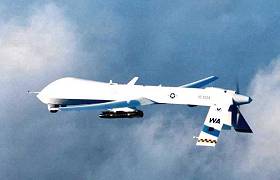
The missile used in phase one, the AGM 114C, has an analog guidance and control system. A different missile, the AGM114K (Hellfire II missile), was used in phase two because it has a digital guidance and control system.
Also, more missiles were fired in Phase Two at more operationally representative altitudes and engagement ranges and they will be fired at moving targets.
On Apr. 17, the Air Force successfully fired three Hellfire II anti-tank missiles from a Predator recon drone, striking three tanks on a target range.
The weaponization of the Predator UAV is a priority of Air Combat Command chief Gen. John Jumper. Jumper has been particularly vocal about his goal of reducing sensor-to-shooter kill times to under ten minutes; mobile targets were particularly elusive and troublesome to the Air Force during Operation Allied Force. Equipping Predator with its own weapon could help the service meet that goal.
Sources say one challenge during Operation Allied Force involved assigning a strike package to time-critical targets identified and confirmed via Predator's digital TV camera. Too often, the target would elude a strike package before it could strike. However, sources say, a weaponized Predator would be able to kill time-critical targets more swiftly and would avoid the trouble of diverting other strike aircraft.
Air Force Chief of Staff Gen. Michael Ryan also supports the move and roughly $1.5 million in fiscal years 2000 and 2001 was set aside to fund the effort. Predator is also useful as a strike asset because of its low cost relative to other combat systems, Air Force sources say. A production-model Predator is valued at approximately $3.8 million, they added.
Air Force officials consider Predator an "attritable" asset because of its low cost; service officials say the loss of seven Predators per year is acceptable. Several recent crashes have vexed program officials, however. In the most recent crash, an Air Force Materiel Command Predator and its equipment, valued at about $2.8 million, was lost.
Text sources: "State Department Finds No Treaty Implications In UAV Weaponization", Inside The Air Force, January 5, 2001; Sue Baker, "Predator missile launch test totally successful", Aeronautical Systems Center Public Affairs, February 27, 2001; Beth Skarupa, "Air Force Predator goes on the prowl with Army Hellfire", Redstone Arsenal Public Affairs, 4 April, 2001 (rewriting: Cpt Ludovic Monnerat)
© 2001 CheckPoint |














